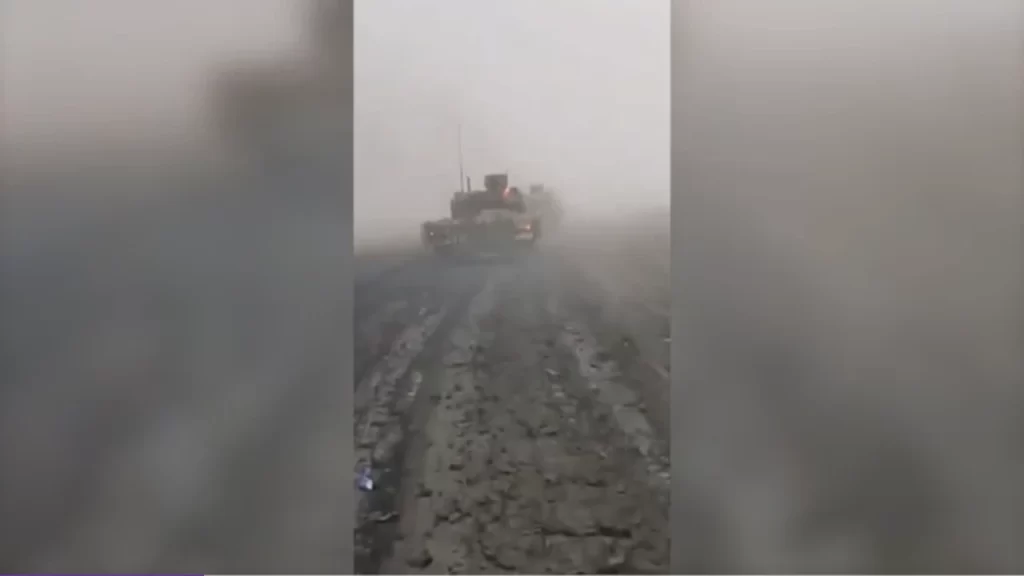The Russian Ground Forces have increased their deployment of sophisticated T-14 “Armata” main battle tanks in the special operations zone in Ukraine, according to an unnamed source that RIA Novosti cited. The first experimental military use of these tanks on the battlefield was revealed in the autumn of 2022.
They have not yet engaged in direct assault activities, the agency stated, citing the source. Instead, they perform the function of mobile artillery, firing their armaments at hostile places and clusters of enemy vehicles.
According to a news agency source, T-14 Armata personnel have been refining their use of these advanced tanks on Donbas training grounds since the end of last year.
The T-14s participating in the Russian special operation have “additional side protection against anti-tank ammunition,” said the source. Before combat, this one-of-a-kind armoured vehicle was outfitted with additional protection based on the Eastern Military District’s experience with other tanks. The Armata’s additional protection against anti-tank guided missiles of NATO design has not been specified. In the recent T-72 upgrades, the sides of the tank and the rear portion of the hull, which contains the engine and gearbox compartment, were outfitted with screens designed to shield the tank from the cumulative effects of ammunition. Armata’s second line of defence includes “Malachite” ERA, located directly on the armour. Malachite ERA is hinged containers with explosives which meet the projectile near the tank. They are capable of withstanding armour-piercing feathered sub-calibre projectiles and heavy ATGM missiles.
The T-14 “Armata” is a tank of the next generation with an unmanned turret. It is outfitted with a unified tactical control system, allowing it to be deployed efficiently within the framework of a network-centric local combat operation. The combat weight of the tank is around 55 tonnes. It is armed with a 125-mm gun that can fire 45 different types of rounds.
T-14 Armata Tank as a mobile artillery
These tanks use High-explosive fragmentation shells (HE-FRAG shells) from concealed firing positions to strike fortifications and concentrations of Ukrainian Armed Forces vehicles on the Kupyansk (in Kharkiv) and maybe other operational directions. Advanced digital ballistic computers integrated into the fire control systems guide the rounds along specified trajectories. These rounds burst in midair, showering the area with high-velocity shrapnel and causing extensive damage to enemy troops and machinery. HE-FRAG shells have little or no armour-piercing capabilities; hence they are good against light vehicles, fortifications or creating craters.
Armata’s Gun
Armata now boasts the most modern smoothbore gun, the 2A82-1M, which has a slightly greater permissible crushing pressure and a significantly higher number of barrel channels, approximately 850-900 rounds, than the earlier 2A46M and 2A46M1 guns. This characteristic lowers the number of geometric micro-deformations caused by propellant gas impact. It adds to a 17% boost in muzzle energy compared to the German Rh120/L55 gun.
The optical-electronic instrument for barrel bend measurement UUI-2 is integrated into the weapon control system.

Using recoilless-free pin fittings with reverse action wedges and elastic rollers on 2A82-1M guns reduces the impact of fitting play on firing accuracy. The grouping of shots from these guns outperforms the performance of older versions of the gun by roughly 17-20%.
Armata’s Self protection
The four AFAR ( Advanced Fixed-Array Radar) modules mounted on the tank turret create a full-circumference distributed aperture of the vehicle’s radar complex, allowing detection of enemy fragmentation and high-explosive rounds at a range of 7-12 km and reactive shells at a range of 20-25 km.
The battle information and control systems of the T-14 “Armata” tanks can determine the firing positions of enemy tanks and artillery at distances of up to 20 km along the ascending and descending trajectories of these projectiles.
As a result, these tanks can be deployed in counter-battery battles. Furthermore, this all-purpose multifunctional radar detects and tracks the trajectory of anti-tank guided missiles, such as Brimstone-2 / AGM-179 Joint Air-to-Ground Missile (JAGM) Ukrainians used to breach the operational direction of Melitopol. Target designation, including azimuthal and angular spatial coordinates of the enemy tactical missile/projectile’s approach, can be sent to the “Afghanite” active defence complexes after detection and tracking.
The generation of microwave transistors of AFAR modules based on substrates made of heat-resistant low-temperature co-fired ceramics (LTCC) enables operation in higher energy modes, resulting in an exceptional range of detection of low RCS projectiles.
Another key aspect of these radar systems is their capacity to operate in weather conditions when gunners’ optoelectronic, panoramic, and multi-channel sights are less effective. Radar systems can fire on radio-contrast ground targets within the radar’s range of view.
However, because guided anti-tank missiles “Invar-M1” and guided high-explosive fragmentation shells 9M119F1 are equipped with a semi-automatic laser-beam control system that requires favourable air conditions, their use in complex weather conditions is still prohibited. As a result, firing precision is only ensured when high-explosive fragmentation and armour-piercing sub-calibre or cumulative shells are used during a direct fire or from closed firing positions.
